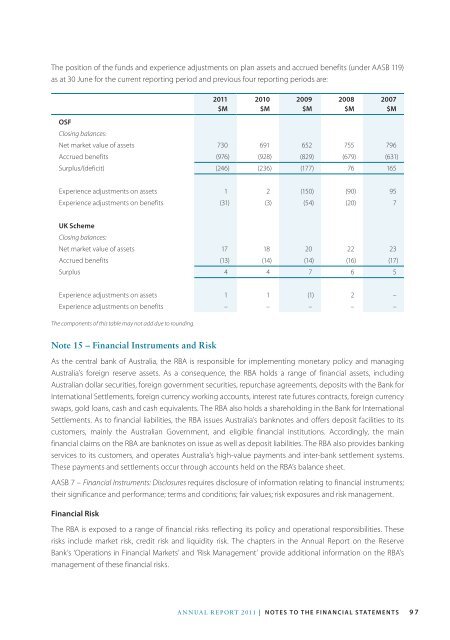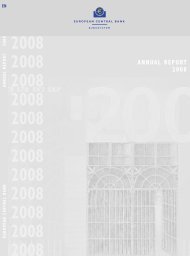Reserve Bank of Australia Annual Report 2011
Reserve Bank of Australia Annual Report 2011
Reserve Bank of Australia Annual Report 2011
Create successful ePaper yourself
Turn your PDF publications into a flip-book with our unique Google optimized e-Paper software.
The position <strong>of</strong> the funds and experience adjustments on plan assets and accrued benefits (under AASB 119)<br />
as at 30 June for the current reporting period and previous four reporting periods are:<br />
<strong>2011</strong><br />
$M<br />
2010<br />
$M<br />
2009<br />
$M<br />
2008<br />
$M<br />
2007<br />
$M<br />
OSF<br />
Closing balances:<br />
Net market value <strong>of</strong> assets 730 691 652 755 796<br />
Accrued benefits (976) (928) (829) (679) (631)<br />
Surplus/(deficit) (246) (236) (177) 76 165<br />
Experience adjustments on assets 1 2 (150) (90) 95<br />
Experience adjustments on benefits (31) (3) (54) (20) 7<br />
UK Scheme<br />
Closing balances:<br />
Net market value <strong>of</strong> assets 17 18 20 22 23<br />
Accrued benefits (13) (14) (14) (16) (17)<br />
Surplus 4 4 7 6 5<br />
Experience adjustments on assets 1 1 (1) 2 –<br />
Experience adjustments on benefits – – – – –<br />
The components <strong>of</strong> this table may not add due to rounding.<br />
Note 15 – Financial Instruments and Risk<br />
As the central bank <strong>of</strong> <strong>Australia</strong>, the RBA is responsible for implementing monetary policy and managing<br />
<strong>Australia</strong>’s foreign reserve assets. As a consequence, the RBA holds a range <strong>of</strong> financial assets, including<br />
<strong>Australia</strong>n dollar securities, foreign government securities, repurchase agreements, deposits with the <strong>Bank</strong> for<br />
International Settlements, foreign currency working accounts, interest rate futures contracts, foreign currency<br />
swaps, gold loans, cash and cash equivalents. The RBA also holds a shareholding in the <strong>Bank</strong> for International<br />
Settlements. As to financial liabilities, the RBA issues <strong>Australia</strong>’s banknotes and <strong>of</strong>fers deposit facilities to its<br />
customers, mainly the <strong>Australia</strong>n Government, and eligible financial institutions. Accordingly, the main<br />
financial claims on the RBA are banknotes on issue as well as deposit liabilities. The RBA also provides banking<br />
services to its customers, and operates <strong>Australia</strong>’s high-value payments and inter-bank settlement systems.<br />
These payments and settlements occur through accounts held on the RBA’s balance sheet.<br />
AASB 7 – Financial Instruments: Disclosures requires disclosure <strong>of</strong> information relating to financial instruments;<br />
their significance and performance; terms and conditions; fair values; risk exposures and risk management.<br />
Financial Risk<br />
The RBA is exposed to a range <strong>of</strong> financial risks reflecting its policy and operational responsibilities. These<br />
risks include market risk, credit risk and liquidity risk. The chapters in the <strong>Annual</strong> <strong>Report</strong> on the <strong>Reserve</strong><br />
<strong>Bank</strong>’s ‘Operations in Financial Markets’ and ‘Risk Management’ provide additional information on the RBA’s<br />
management <strong>of</strong> these financial risks.<br />
<strong>Annual</strong> report <strong>2011</strong> | notes to the financial statements<br />
97





![KNOW YOUR NEW GIBRALTAR BANKNOTES - [Home] bThe/b](https://img.yumpu.com/50890985/1/184x260/know-your-new-gibraltar-banknotes-home-bthe-b.jpg?quality=85)
![PAPUA NEW GUINEA - [Home] - Polymer Bank Notes of the World](https://img.yumpu.com/49758743/1/190x143/papua-new-guinea-home-polymer-bank-notes-of-the-world.jpg?quality=85)










